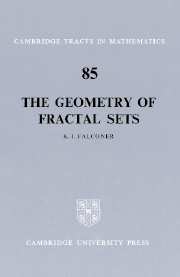
-
Select format
-
- Publisher:
- Cambridge University Press
- Publication date:
- January 2010
- January 1985
- ISBN:
- 9780511623738
- 9780521337052
- Dimensions:
- Weight & Pages:
- Dimensions:
- (228 x 152 mm)
- Weight & Pages:
- 0.27kg, 180 Pages
You may already have access via personal or institutional login
Book description
This book contains a rigorous mathematical treatment of the geometrical aspects of sets of both integral and fractional Hausdorff dimension. Questions of local density and the existence of tangents of such sets are studied, as well as the dimensional properties of their projections in various directions. In the case of sets of integral dimension the dramatic differences between regular 'curve-like' sets and irregular 'dust like' sets are exhibited. The theory is related by duality to Kayeka sets (sets of zero area containing lines in every direction). The final chapter includes diverse examples of sets to which the general theory is applicable: discussions of curves of fractional dimension, self-similar sets, strange attractors, and examples from number theory, convexity and so on. There is an emphasis on the basic tools of the subject such as the Vitali covering lemma, net measures and Fourier transform methods.
Reviews
‘This book is filled with the geometric jewels of fractional and integral Hausdorff dimension. It contains a much-needed unified notation and includes many recent results with simplified proofs. The theory is classically and rigorously presented with applications only alluded to in the introduction. Each chapter contains a short and important problem set. This is a lovely introduction to the mathematics of fractal sets for the pure mathematician.’
Source: American Mathematical Monthly
Contents
Metrics
Altmetric attention score
Full text views
Full text views help Loading metrics...
Loading metrics...
* Views captured on Cambridge Core between #date#. This data will be updated every 24 hours.
Usage data cannot currently be displayed.
Accessibility standard: Unknown
Why this information is here
This section outlines the accessibility features of this content - including support for screen readers, full keyboard navigation and high-contrast display options. This may not be relevant for you.
Accessibility Information
Accessibility compliance for the PDF of this book is currently unknown and may be updated in the future.


